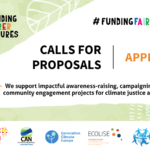BLOG POST
Rich countries are off track on a cornerstone of the Paris Agreement. The commitment to mobilise $100 billion climate finance annually between 2020-25 for poorer countries was first made back in 2009, and reiterated in the Paris Agreement. Climate finance helps those countries deal with devastating climate impacts and deliver on climate commitments, some of which are conditional on climate finance.
However a delivery plan published on October 25th showed that the $100 billion will be met only in 2023. Projections in the plan indicate that the goal will be exceeded in subsequent years to $117 billion in 2025, leading to little more than $500 billion mobilized on average from 2021-2025. But astoundingly this plan writes off the goal in 2020, and does not commit to delivering $600 billion in the 5-year period as suggested by climate vulnerable countries. Nor does it include an adequate timeline or concrete actions for achieving the baCFGlance between mitigation and adaptation finance, or scale up support for least developed countries and small island developing states (as agreed in Paris).
The failure to reach the $100 billion looms large over the COP26 negotiations. While recently published ECOFIN Council Conclusions on climate finance give some positive signals, they lack ambition and specific commitments, and have some glaring omissions. The European Council and the European Commission would do well to draw on the clear calls for action in the European Parliament’s COP26 Resolution.
Ahead of the G20 President of the European Commission, Ursula Von der Leyen, has rightly called for rich countries to “provide the $100 billion already next year,” as “a question of credibility.” Moreover it is quite clear from multiple analyses on energy investment, adaptation finance and loss and damage forecasts, that we are looking at the need for trillions not billions over the next decade. As the world’s largest climate finance contributor, the EU’s contributions to and positioning on climate finance at the negotiations can make a real difference. Here’s what the EU can do on finance to set things on a better trajectory:
1. Scaling up finance
The EU provides climate finance collectively through the EU budget, through Member States’ public budgets and other development finance institutions, through bilateral and multilateral contributions. Some EU Member States top the rankings internationally in the quantity and quality of their climate finance contributions, but others contribute far below their fairshare.
The EU has just published its total climate finance in 2020, which puts the contribution of EUR 23.39 billion in 2020. This figure includes EUR 2.5 billion climate finance from the EU Budget and the European Development Fund, and EUR 2.7 billion from the European Investment Bank (EIB).
While this represents an increase on its total in 2019, which stood at 21.9 billion EUROS, this year the EU is using a new reporting methodology, and it’s not yet clear how EU countries are interpreting the rules for reporting different instruments. While ‘close to half’ of 2020 finance was committed in the form of grants, instruments such as non-concessional loans or export credits could be inflating figures – these should not be counted towards the $100 billion since they do not represent a net transfer of wealth, and can exacerbate indebtedness.
What is clear is that the $100 billion was not met in 2020, and that the EU is not delivering its fairshare. So more EU Member States should come forward to announce new increases in climate finance. Italy, co-President of the COP and President of the G20 has announced an increase in climate finance just ahead of the COP on the fringes of the G20 Summit (30-31 October) which is a start. Italy will nearly triple its financial commitment to 1.4 billion dollars per year for the next 5 years, but more clarity is needed about how this finance will be delivered, and it is still far from Italy’s fairshare which NGOs put at $4 billion per year. More Member States should come forward at the COP itself. How the money is delivered and where it goes also really matters, and having a stronger focus on gender equality should be a key focus for all climate financing.
When it comes to EU budget funds, the Commission President’s recent announcement of an extra €4 billion for international climate finance by 2027 through the Global Europe Instrument was a welcome increase. This should be followed by more finance in subsequent years. However the Commission now needs to provide clarity on how the extra finance will be spent. To address current gaps this money should go into global climate programmes, and into reinforcing adaptation under the upcoming EU Africa Partnership Strategy, and should be strongly integrated with gender equality.
2. Becoming Adaptation Finance Champions
In 2020, the latest EU statement tells us, close to 50% of the EU’s funding for developing countries was dedicated to either climate adaptation or cross-cutting action (addressing both mitigation and adaptation). However there is no clarity about the shares between the two, or what the shares in cross-cutting look like, where adaptation is likely to be over-reported.
At the start of 2021 the UN Secretary General called on parties to achieve a balance between mitigation and adaptation finance, since there is a serious adaptation finance gap. Recently a new Champions Group on Adaptation Finance including the Netherlands, Denmark, Sweden, Finland, the UK and Ireland joined a push aiming to get commitments to achieve 50% balance. More European countries and EU Member States should make the adaptation commitment, although this should not be a replacement for scaled up climate finance. European countries should channel more adaptation finance through the UNFCCC Adaptation Fund, and provide multi-year commitments to give the fund more certainty.
The G20 communique agreed at the weekend also specifically references the need to scale up adaptation finance. COP26 will need to put that communique into action.
3. Exploring new and additional finance for loss and damage from climate impacts
Loss and damage finance is a key priority for climate vulnerable countries, who are looking at trillions of dollars of losses by 2030. Although recognised in Article 8 of the Paris Agreement, the EU is not currently providing loss and damage finance upfront. While some financing does go to avert and minimises losses and damages, through mitigation and adaptation, and disaster risk reduction, the small amounts to address losses and damages through humanitarian aid budgets are far too scant.
The EU needs to give loss and damage some serious attention at COP26, including through a permanent agenda item on loss and damage from COP26 onwards, and supporting an effective operationalisation of the Santiago Network on Loss and Damage, which should be set-up to deliver technical assistance and capacity building, to develop and create access to knowledge and information on loss and damage at scale of impact, and foster coordination and collaboration among stakeholders.
Channeling new sources can play a dual role in shifting finance out of harmful activities. Sources could include new levies on international aviation or maritime transport, a climate damages tax on fossil fuel exploration, or rich countries could put their special drawing right allocations from the IMF into a special fund, or debt cancellation in the event of an extreme weather event. The EU should ally with climate vulnerable countries and other progressive bridge-builders to task the Warsaw International Mechanism on Loss and Damage to explore sources of finance.
4. The future climate finance goal
Finally, since parties will start process discussions around a new climate finance goal to replace the $100 billion after 2025, the EU should ensure that it learns lessons on delivery on the $100 billion in setting up the new goal. Putting in place separate sub-goals for different types of finance (grants-based), as well as purposes: mitigation, adaptation, loss and damage would make sense. Targets should also be science and needs-based. African negotiators have stated that $1.3 trillion is needed by 2030. It is quite clear from multiple analyses on energy investment, adaptation finance and loss and damage forecasts, that we are looking at the need for trillions not billions.



